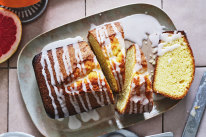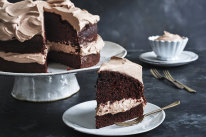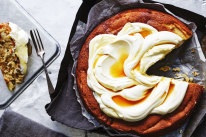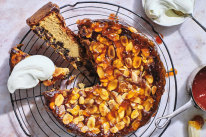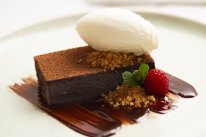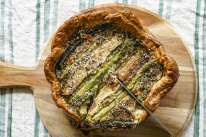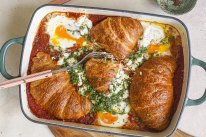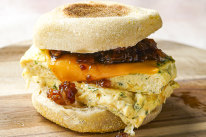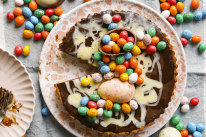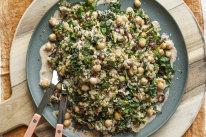Marble chocolate layer cake with chocolate buttercream, chocolate crumb and Easter eggs
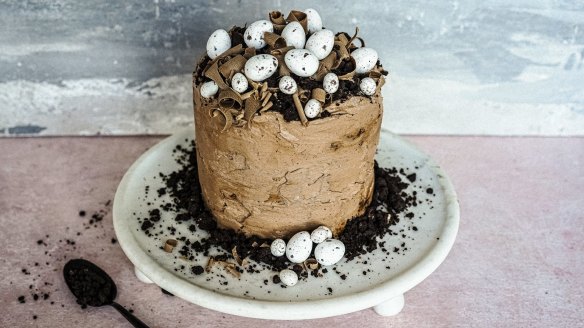
This cake uses the reverse creaming method. Mixing the butter then eggs into the dry ingredients helps create a far more superior crumb and a light and lovely sponge. The results are far more consistent, and this is what we want and need when we go to the effort of making a cake.
Ingredients
Marbling
85ml hot water
30g Dutch cocoa powder
Cake
450g low protein cake flour
450g caster sugar
heaped tsp salt
2 tbsp baking powder
225g unsalted butter, softened and diced
½ tbsp vanilla bean paste
4 large eggs, at room temperature
400ml buttermilk, at room temperature
100ml vegetable oil (or any flavourless oil)
Chocolate buttercream
80g milk chocolate
20g Dutch cocoa powder
180g eggwhites
210g caster sugar
300g unsalted butter, softened to room temperature, chopped into tablespoon-sized chunks
pinch salt
To decorate
Chocolate cookie crumb (optional)
realistic looking Easter eggs (I used Koko Black hazelnut praline eggs)
½ cup shaved chocolate
Method
1. Preheat the oven to 165C fan-forced (185C conventional) and grease and line 3 x 23cm-round springform tins.
2. For the marbling, heat the water in a saucepan until simmering. Pour into a bowl, add the cocoa powder and stir with a fork. It will be a little lumpy but continue to mix until it becomes a thickish liquid. Set aside to cool while you prepare the batter.
3. For the cake, add the flour, sugar, salt and baking powder to the bowl of a stand mixer, fitted with the paddle attachment. Pulse briefly to combine, then add the butter, in pieces, until incorporated – the mixture should resemble a sandy crumble. Beat for a minute or so here, this is building the structure so it's important not to rush this step.
4. Add the vanilla then add the eggs, one at a time, and mix until incorporated before adding the next. Turn the mixer speed to low and slowly add the buttermilk, mixing until incorporated, then add the vegetable oil.
5. Take a scant third of mixture and add to the bowl of marbling mixture and use a spoon to gently fold and combine.
6. Layer the batter into your pans, starting with vanilla, then chocolate and ending with vanilla. You just want blobs of mixture, nothing overly precise. Use a knife to gently swirl the batter together in a few spots. Don't over-mix or the cake won't have a marbled interior.
7. Bake the cakes for 35-40 minutes, or until a cake tester inserted into the centre comes out clean, or the centre of the cake springs back to your touch. Let the cakes cool for 10 minutes inside the tins before gently flipping them out. Wrap the cakes in clingfilm and place in the fridge to continue to cool. (As the cakes cool inside the clingfilm, they steam, and this adds further moisture to your sponge.)
8. To make the buttercream, put the chocolate into a heatproof bowl set over a saucepan about a third-full of boiling water. Do not let the base of the bowl touch the water below. Stir, until the chocolate has melted, then remove and set aside to cool to a tepid temperature (keep the water in the saucepan). Stir through the cocoa powder, using a fork to remove any lumps.
9. Put the eggwhites and sugar into the bowl of a stand mixer. Set it over the same saucepan filled with water. Heat, whisking constantly, until it reaches about 70C on a thermometer – the sugar will be dissolved and the mixture hot to the touch. Immediately remove then set the bowl onto a stand mixer fitted with the whisk attachment. Whisk on high speed until a thick and glossy meringue has formed and the bowl has cooled to room temperature (about 5-7 minutes). Add the butter, about a tablespoon's worth at a time, until fully incorporated. Lower the speed, gently add the melted chocolate mixture and beat until combined.
10. To assemble, place a sponge on a plate. Smear over a quarter of the buttercream. Place the second sponge on top. Smear over another quarter of icing and top with final sponge. Add remaining buttercream all over the cake – we are not aiming for perfection here – and use a pallet knife to smooth the sides and create some lovely ripples on top.
11. Sprinkle over the chocolate cookie crumb, if using, then top with shaved chocolate. Lastly top with the Easter eggs.
Note: This cake is best served at room temperature. Given the butter content of the buttercream, cold from the fridge is not ideal.
Appears in these collections
The best recipes from Australia's leading chefs straight to your inbox.
Sign up
